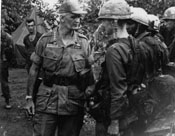- Exhibits
- Tet Offensive
- Situation Prior to Tet
The Tet Offensive (Tết Mậu Thân)
- The Tet Offensive (Tết Mậu Thân)
- Hue: The Imperial City
- The Battle of Khe Sanh
- The Battle for Saigon
- Aftermath of the BattlesPolitical ConsequencesExhibit Credits
The Situation Prior to Tet

General W.C. Westmoreland congratulates men of 25th Infantry Division for their actions during Operation Paul Revere, Vietnam. Photographer: Army News Feat.
(U.S. Army Aviation Museum Volunteer Archivists Collection [va058606])Prior to the Tet Offensive the United States believed that it was winning the Vietnam War. There had been no decisive battles, but American forces had bested the communists in nearly every engagement that had been fought. Their strategy of attrition seemed to be working as American forces were defeating the communist soldiers and accumulating a high body count. As a result, the US military began to believe that its tactics were "grinding the communists down," and that they would soon give up their guerrilla war. However, the American public was beginning to show signs of war weariness, as the fighting continued to rage with no end in sight. In an effort to counter anti-war sentiment, the administration of US President Lyndon B. Johnson initiated a good-will tour in November of 1967 to help restore American confidence in the war effort. During this public relations campaign, Gen. William C. Westmoreland assured the American public that the war had reached a point "where the end comes into view." However, the massive enemy offensive that took place a mere two months later shattered all illusions of a forthcoming victory.
Read More:- Message From General Westmoreland To General Abrams: Concept Of Situation Portrayed During Recent Visit To Washington (5 pages) [26 November 1967] - 0240817011(see full record)
- Memo To President Lyndon B. Johnson From McGeorge Bundy: A Commentary On The Vietnam Discussion Of November 2, 1967 (14 pages) [10 November 1967] - 0240812012(see full record)
Vietnam Center & Sam Johnson Vietnam Archive
-
Address
Texas Tech University, Box 41041, Lubbock, TX 79409 -
Phone
(806)742-9010 -
Email
vnca@ttu.edu

